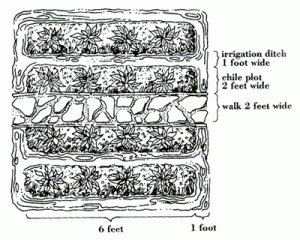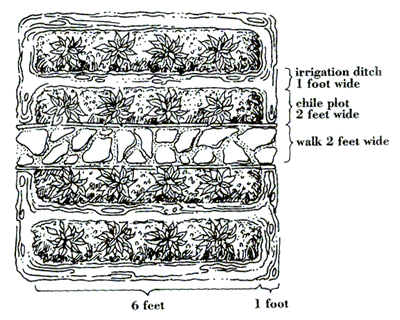After years of growing peppers in small plots in the Southwest, we have developed a system that works well because it allows us to grow peppers with most of the other vegetables and herbs in the garden. It also maximizes space in a narrow garden, provides excellent access, and allows quick and efficient irrigation. Essentially, it combines elements of both ridges and furrows and flat beds, and can be used in gardens with a slight slope.

Modified irrigated beds
A brick, stone, or concrete walkway down the center of the garden allows easy access. In the plot on each side of the walkway, a shallow center furrow is cut to provide irrigation. From these center furrows, side furrows are cut so that the plants have their own slightly raised beds that are not as tall as conventional ridges. During irrigation, these small beds will be usually be surrounded by water on three sides. Irrigation is easy because the hose is placed at one end of each bed, and the furrows quickly fill. The grower can control the spread of water in sloping gardens with small dams made from soil or sections of two-by-fours.
This design will also work in wetter regions if the soil is well-drained. In extremly wet regions, a flat bed without furrows is better. One drawback is that the walkway takes up a lot of space; however, it is relatively weed-free and can be utilized during irrigation.
Latest posts by Mark Masker (see all)
- 2024 Scovie Awards Call for Entries - 07/07/2023
- 2024 Scovie Awards Early Bird Special: 3 Days Left - 06/29/2023
- 2024 Scovie Awards Early Bird Deadline Looms - 06/25/2023








